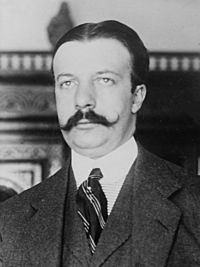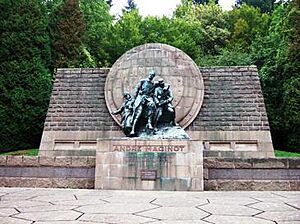André Maginot facts for kids
Quick facts for kids
André Maginot
|
|
|---|---|

André Maginot
|
|
| Minister of War | |
| In office 27 January 1931 – 6 January 1932 |
|
| Preceded by | Louis Barthou |
| Succeeded by | André Tardieu |
| In office 2 March 1930 – 13 December 1930 |
|
| Preceded by | René Besnard |
| Succeeded by | Louis Barthou |
| In office 3 November 1929 – 21 February 1930 |
|
| Preceded by | Paul Painlevé |
| Succeeded by | René Besnard |
| Personal details | |
| Born | 17 February 1877 Paris, France |
| Died | 7 January 1932 (aged 54) Paris, France |
| Nationality | |
| Awards | Médaille militaire |
| Military service | |
| Allegiance | |
| Branch/service | |
| Years of service | 1914–1917 |
| Rank | Sergeant |
| Battles/wars | World War I |
André Maginot (born February 17, 1877 – died January 7, 1932) was an important French leader. He worked for the government, was a soldier, and a member of Parliament. He is most famous for pushing to build a huge line of forts. This line of forts is known as the Maginot Line.
Early Life and War Service
André Maginot was born in Paris, France. He spent his childhood summers in a village called Revigny-sur-Ornain. This village was in a part of France called Lorraine.
In 1897, André started working for the French government. He worked as an assistant in Algeria until 1910. After that, he decided to get involved in politics. He was elected to the French Parliament that same year. Before World War I started in 1914, he worked as a special helper for the Minister of War.
When World War I began, Maginot joined the army. He fought along the border area of Lorraine. In November 1914, he was promoted to sergeant. This was because he showed great bravery and calmness. He was wounded in the leg near Verdun and walked with a limp for the rest of his life. For his extreme courage, he received a special medal called the Médaille militaire.
Building the Maginot Line
After the war, André Maginot went back to Parliament. He held several important government jobs. These included Minister of Overseas France and Minister of War. He was Minister of War several times between 1922 and 1932.
Maginot believed that the peace treaty after World War I did not make France safe enough. He wanted France to spend more money on its defense. He also became more worried about Germany. Even though many people in France did not want to think about another war, Maginot did.
He strongly believed that France needed a strong defense system. He wanted to build a long line of forts along France's border with Germany. This line would have both temporary army positions and strong concrete forts. He got this idea from seeing how well forts worked at Verdun during the war. He was also sad that his childhood home was destroyed in the war. This made him determined to protect Lorraine from ever being invaded again.
In 1926, Maginot convinced the government to give money for building test parts of this defense line. He worked very hard to get Parliament to approve the money. Finally, he succeeded, and a huge amount of money was approved for the project.
The building of the line moved very quickly. Maginot visited the construction sites in 1930. He was very happy with the progress. He was especially pleased with the work in Lorraine, his childhood home. He fought for even more money to build in that area. André Maginot was the main person who pushed for this project. However, many of the actual designs for the Maginot Line were created by Paul Painlevé. Painlevé was Minister of War after Maginot.
Death and Legacy
André Maginot never saw the defense line finished. He became sick in December 1931 and died in Paris on January 7, 1932. He passed away from a disease called typhoid fever. Many people in France were very sad when he died. It was only after his death that the line of defenses he had worked so hard for was named the Maginot Line.
During World War II, Germany found a way around the Maginot Line. German tanks went through hills and marshlands. These areas were thought to be impossible for tanks to cross when Maginot made his plans.
A monument was built to remember André Maginot. It was placed near Verdun in September 1966.
See Also
 In Spanish: André Maginot para niños
In Spanish: André Maginot para niños


